Iconic Hair And Makeup Looks From Horror Films
Wednesday, October 23, 2019
With Halloween nearly upon us, our social media timelines are about to be chock-full of scarily good makeup looks inspired by some of our favourite films.
While there’s a trend for recreating iconic film characters with DIY hair and makeup, we look to the professional teams who originated some of the most iconic monsters in cinematic history.
From werewolves and vampires to zombies and killer clowns, here are 6 of the most iconic hair and makeup looks from horror films, and how they were made…
An American Werewolf in London (1981)
Special effects makeup artist, Rick Baker, is renowned for his work on horror films including The Exorcist and The Ring.
But his work on An American Werewolf in London won him the Oscar for Best Makeup the first year the category was introduced.
In the film, we see the main actor transform into a werewolf in a terrifying scene that’s packed with practical FX.
Firstly, a full body cast was taken of the actor to mould prosthetics. Baker actually based the look on his dog, and as the actor morphs, his body parts stretch and become wolf-like. This was achieved using syringe pumps to extend the prosthetic during the shot.
A large wolf suit was created using a skeleton with a latex wolf body applied over it. Hair was then punched into the wolf suit and three different heads made from rubber urethane, a flexible material, were used for the different stages of the character’s transformation.
For the scenes where the werewolf is wreaking havoc around the city, a dancer had to walk on his hands inside the suit and hold his lower body up to create the illusion of the werewolf crawling.
Beetlejuice (1988)
Another classic character that has inspired Halloween costumes since the film’s release is Beetlejuice.
Designer Ve Neill worked closely with director, Tim Burton, to come up with the creepy look for the titular character, and to achieve it she had to use some interesting techniques.
Firstly, Beetlejuice is meant to be dead, so looks a little off-colour throughout the film. To achieve that look, Neill used a pale yellow, almost-white colour on the actor’s skin. Then, for the dark eye circles, dark brown and purple paints were mixed together.
To add to the dishevelled look, Beetlejuice’s nose appears broken but Ve Neill explains they didn’t have any broken nose prosthetics on set so had to improvise. Instead, she took two swollen lips pieces and glued one to each side of the actor’s nose for the broken effect.
Finally, crushed green foam from the hobby store was used as moss and creeps out of the character’s hairline and around his mouth and neck.
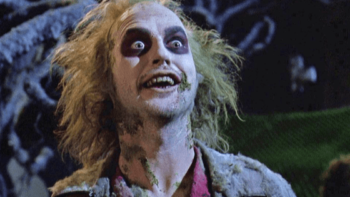
(Image courtesy of IFC Center)
Bram Stoker’s Dracula (1992)
When we think of Dracula, a cape, slick black hair and fangs usually come to mind. But for Francis Ford Coppola’s 1992 film, the hair and makeup team gave Dracula several different looks winning hair and makeup designer, Michele Burke, special makeup effects artist, Greg Cannom, and prosthetics makeup artist, Matthew W. Mungle, the Oscar.
We first meet Dracula as an old man in one of the most recognisable looks from the film. Gary Oldman was just 34 when he filmed Bram Stoker’s Dracula, so the look called for ageing makeup which Greg Cannom is renowned for.
The look is finished with a white wig and knife-like nails. To help exaggerate the wig and make the makeup application easier, Oldman shaved his hairline.
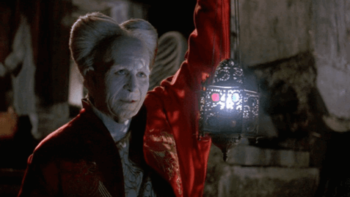
(Image courtesy of the Film Experience)
Shaun of the Dead (2004)
Halloween isn’t complete without zombies, and film and TV makeup has given us plenty of undead characters to take inspiration from.
Shaun of the Dead is one horror/comedy flick that called for a lot of zombie makeup. To achieve that look, prosthetics makeup artist on the film and tutor at The Iver Makeup Academy, Stuart Bray, explains they kept everyone’s individual look by working with their face and then made them look a bit pale, bruised and ‘freshly dead’.
One part of the film, in particular, did call for special FX, as one of the main characters is torn apart by zombies.
A fake body section was applied to the actor’s neck with limbs held on by carefully trimmed cable ties. There was also a cavity inside the fake body filled with fake guts which the zombies pulled out.
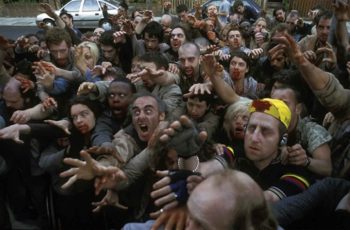
Black Swan (2010)
Another creepy film that has inspired Halloween makeup looks since its release is Black Swan.
Judy Chin, the makeup designer, had a background in the New York City Opera and brought some of those techniques to the film set.
To create the flawless porcelain finish on Natalie Portman’s face, Chin used white cake makeup which is commonly used in the opera and ballet. This type of makeup is mixed with water before being applied to the actor’s face. It has a dense coverage, which makes the swan’s skin look almost stony.
For the eyes, Judy Chin explains she used “a black MAC Chromaline eyeliner on top, and mixed MAC silver pigment powder with Ben Nye makeup sealer and applied it in feathery strokes. On the lips, it was MAC Dubonnet with MAC Vino lip liner underneath.”
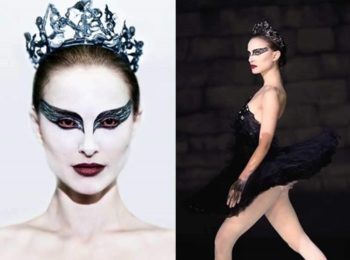
(Image courtesy of Fox Searchlight)
IT (2017)
Finally, one of the most recognisable horror film makeup looks from recent years comes from blockbuster, IT.
Pennywise the clown is played by Bill Skarsgård and the look was designed by Tom Woodruff Jr. and Alec Gillis. To create the monster, the artists took a lifecast of Skarsgård then created a foam latex head, nose tip and cheek pieces to create an egg-like shape.
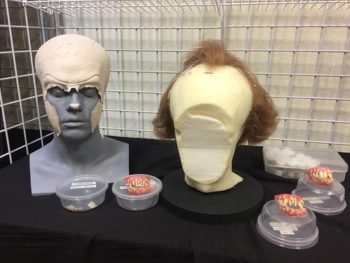
(Image courtesy of AMFM magazine)
Before applying the prosthetics pieces, they were pre-painted to define the cracks on the forehead. Then, the wig was applied on top and different sets of dentures were used to create the buck-tooth effect. In the more climactic scenes, different dentures with jagged teeth were used for an added effect.
In total, the makeup took around 2 and a half hours to apply each day, and 30 minutes to remove.
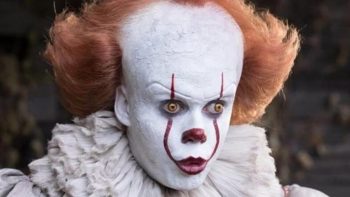
(Image courtesy of looper)
So much goes on behind-the-scenes to create the horror makeup looks we know and love. Or are terrified of…
If you want to learn more about what it takes to be a makeup artist for film and TV, check out our courses or get in touch with our friendly team.
